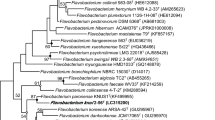Abstract
“Flavobacterium arborescens” (Frankland and Frankland) Bergey et al. IFO 3750 (ATCC 4358) is a Gram-positive, coryneform bacterium and the only available reference strain of the species. The cell wall peptidoglycan of the organism possesses alanine, glycine, lysine, glutamic acid plus 3-hydroxyglutamic acid, and homoserine at a ratio of 1:3:1:1:1, and a possible peptidoglycan structure is the B1β type described by Schleifer and Kandler. Cell wall sugars are galactose, mannose, and 6-deoxy-l-talose, but not rhamnose. Major menaquinones are unsaturated MK-11 and MK-12. These findings and other taxonomic properties suggest that “F. arborescens” should be reclassified in the genusMicrobacterium (Orla-Jensen) Collins et al., asMicrobacterium arborescens comb. nov., nom. rev.
Similar content being viewed by others
Literature Cited
Buchanan, R. E., Gibbons, N. E. 1974. Bergey's manual of determinative bacteriology, 8th edn. Baltimore, Williams and Wilkins.
Collins, M. D., Jones, D. 1981. The distribution of isoprenoid quinone structural types in bacteria and their taxonomic implications. Microbiological Review45:316–354.
Collins, M. D., Jones, D., Kroppenstedt, R. M. 1983. Reclassification ofBrevibacterium imperiale (Steinhaus) and “Corynebacterium laevaniformans” (Dias and Bhat) in a redefined genusMicrobacterium (Orla-Jensen), asMicrobacterium imperiale comb. nov. andMicrobacterium laevaniformans nom. rev.; com. nov.. Systematic and Applied Microbiology4:65–78.
Collins, M. D., Pirouz, T., Goodfellow, M., Minnikin, D. E. 1977. Distribution of menaquinones in actinomycetes and corynebacteria. Journal of General Microbiology100:221–230.
Collins, M. D., Shah, H. N., Minnikin, D. E. 1980. A note on the separation of natural mixtures of bacterial menaquinones using reverse-phase, thin-layer chromatography. Journal of Applied Bacteriology48:277–282.
Cowan, S. T., Steel, K. J. 1965. Manual for the identification of medical bacteria. London: Cambridge University Press.
Hough, L., Richardson, A. C. 1967. The monosaccharides: pentoses, hexoses, heptoses and higher sugars, pp. 67–595. In: Coffey, S. (ed.), Rodd's chemistry of carbon compounds, 2nd edn., vol. 1F. Amsterdam: Elsevier.
Jones, D. 1975. A numerical study of coryneform and related bacteria. Journal of General Microbiology87:52–96.
Keddie, R. M., Leask, B. G. S., Grainger, J. M. 1966. A comparison of coryneform bacteria from soil and herbage: cell wall composition and nutrition. Journal of Applied Bacteriology29:17–43.
Lechevalier, M. P., Lechevalier, H. A. 1980. The chemotaxonomy of actinomycetes, pp. 227–292. In: Dietz, A., Thayer, D. W. (eds.),Actinomyces taxonomy. Society for Industrial Microbiology, Arlington, VA.
MacLenan, A. P. 1961. Composition of the cell wall ofActinomyces bovis: the isolation of 6-deoxy-l-talose. Biochimica et Biophysica Acta48:600–601.
Robinson, K. 1966. Some observations on the taxonomy of the genusMicrobacterium. II. Cell wall analysis, gel electrophoresis and serology. Journal of Applied Bacteriology29:616–624.
Schleifer, K. H. 1970. The murein types of the genusMicrobacterium [in German, with English summary]. Archiv für Mikrobiologie71:271–282.
Schleifer, K. H., Kandler, O. 1972. Peptidoglycan types of bacterial cell walls and their taxonomic implications. Bacteriological Reviews36:407–477.
Skerman, V. B. D., McGowan, V., Sneath, P. H. A. 1980. Approved lists of bacterial names. International Journal of Systematic Bacteriology30:225–420.
Takeuchi, M., Imai, K. 1984. Composition of 6-deoxy-l-talose-containing cell wall ofFlavobacterium arborescens IFO 3750 [in Japanese, with English summary]. Journal of the Agricultural Chemical Society of Japan,58:385–386.
Uchida, K., Aida, K. 1977. Acyl type of bacterial cell wall: its simple identification by colorimetric method. Journal of General and Applied Microbiology23:249–260.
Author information
Authors and Affiliations
Rights and permissions
About this article
Cite this article
Imai, K., Takeuchi, M. & Banno, I. Reclassification of “Flavobacterium arborescens” (Frankland and Frankland) Bergey et al. in the genusMicrobacterium (Orla-Jensen) Collins et al., asMicrobacterium arborescens comb. nov., nom. rev.. Current Microbiology 11, 281–284 (1984). https://doi.org/10.1007/BF01567386
Issue Date:
DOI: https://doi.org/10.1007/BF01567386




